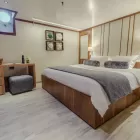- Ship
- 1 Breakfast, 1 Lunch, 1 Dinner
North Seymour Island was lifted from the ocean floor by a seismic event, and its origins as a seabed give the island its low, flat profile. Cliffs only a few meters high form much of the shoreline, where swallow-tailed gulls sit perched in ledges. A tiny forest of silver-grey Palo Santo trees stands just above the landing, usually without leaves, waiting for the rain to bring them into bloom. This island is teeming with life! You might have to give way to a passing sea lion or marine iguana. Blue-footed boobies nest on either side of the trail where mating pairs perform their courtship dance. You are likely to see fluffy white chicks peeking out from beneath their protective mothers. The trail follows the eastern shore along the beach. You may be fortunate to witness flocks of brown pelicans and blue-footed boobies hunting schools of fish. The boobies, which look so comical on land, are ideally adapted as dive bombers and easily pierce the water, zeroing in on their targeted prey. Frigate birds with wingspans of up to 5 feet soar overhead and all around. They were named for the way that the trim of their wings in flight are reminiscent of the square-rigged sailing warship. Not coincidentally frigate birds are also called Man O’ Warbirds and they live up to that name in a literal way when they target boobies, pelicans, and other birds to steal their catch. Because the frigates are pelagic, they lack the ability to take off from the water, so they do better at snatching fish from the surface or simply stealing them. They also target marine iguanas and young baby sea turtles.
The trail turns east and inland to reveal the nesting stronghold of the frigates. Here you can see males with large, bright red, inflated throat sacks known as gular pouches, all done in an effort to attract females. Your guide will point out the difference between the Magnificent, or Man O’ War frigates and their Great frigate bird cousins. Large puff-ball frigate bird chicks inhabit nests, waiting for their parents to return with a meal. Even at this young age they possess long hooked beaks and act defiant when they feel threatened. You will also get a closer look at the feathers of the proud parents and notice their iridescent quality and deep green tinge.
Another inhabitant along the trail is the yellow land iguana. The species was originally introduced to North Seymour in 1932 by Captain Alan Hancock and his crew from Baltra with the aim of rescuing the creatures from the poor conditions left by goats and other feral animals. The iguanas colonized the island without a problem. The original colony disappeared from Baltra when it became a US military base in WWII. In 1980 Charles Darwin Station began a breeding program using some of the animals found on Seymour and successfully reintroduced their prodigy to both islands. Today the population on Seymour is roughly 600 and on Baltra 1,500. The snorkeling site at North Seymour also attracts scuba divers. You have a chance to see many types of rays here including marble rays, golden eagle rays, spotted eagle rays, sting rays, and even manta rays. Dormitories of white-tipped reef sharks sleep on the bottom while schools of king angelfish and yellow-tailed surgeonfish swarm the rocky shoreline passing the occasional parrot and damselfish. Some of the rocks are actually well-disguised scorpion fish. Large schools of tightly packed blue and gold snappers, grunts, and jacks are usually found plying these waters. Sea lions pay visits from both Seymour and nearby Mosquera Island as sea turtles and the occasional hammerhead shark can be seen down in the depths. Creole fish, the color of red salsa, hieroglyphic hawkfish, with neon-like etchings on their flanks, and spotfin burrfish, which look a bit like a swimming shoe box with a cartoon face also inhabit the region.
Type of Landing: Dry
Level of Walk: Moderate
Other Activities: Nature Hikes & Snorkeling
Santa Fe offers one of the more beautiful and sheltered coves on the islands. Its turquoise lagoon is protected by a peninsula of tiny islets forming an ideal anchorage. The island lies southeast of Santa Cruz Island within sight of Puerto Ayora. Geologically it is one of the oldest islands in the archipelago and for many years was thought to be a product of an uplift event. Through satellite imagery, it has been possible to determine the island’s volcanic origins. A wet landing on a sandy white beach brings one into contact with one of many sea lion colonies. Bulls contend for the right of being beach masters, while smaller males mask as females to make stealthy mating moves. Galapagos hawks are sometimes easily approached, perched atop salt bushes. An ascending trail leads toward the cliffs, where a dense thicket stands on the inland side of the island. The cliffside provides an expansive view of the ocean. You will be struck by the forest of giant prickly pear cacti found here that live up to their name, with tree-sized trunks! These are the largest of their kind in the Galapagos.
At the top of the trail, the goal is to spot one of the large species of land iguana endemic to Santa Fe. Beige to chocolate brown in color with dragon-like spines, these big iguanas truly resemble dinosaurs. An indigenous species of rice rat also inhabits the thicket, and lucky hikers may spot harmless Galapagos snakes. Santa Fe offers a more advanced kayaking route along its northern shore that ends at sea caves and is subject to conditions.
Type of Landing: Wet
Level of Walk: Moderate
Other Activities: Nature Hikes & Kayaking





















